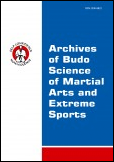2015, Volume 11, Issue 1
Effect of motor abilities on the course of fight and achievement level in judokas at different age
Grzegorz Lech1, Tomasz Pałka2, Anna Tyka3, Janusz Jaworski1, Wiesław Chwała4, Stanisław Sterkowicz1, Tadeusz Ambroży5
1Department of Theory of Sport and Kinesiology, Institute of Sport Sciences, Faculty of Physical Education and Sport, University of Physical Education, Krakow, Poland
2Department of Physiology and Biochemistry, Faculty of Physical Education and Sports, University of Physical Education, Krakow, Poland
3Department of Recreation and Biological Regeneration, Faculty of Tourism and Leisure, University of Physical Education, Krakow, Poland
4Department of Biomechanics, Faculty of Physical Education and Sports, University of Physical Education, Krakow, Poland
5Department of Gymnastics and Dance, Faculty of Physical Education and Sport, University of Physical Education, Krakow, Poland
Author for correspondence: Tomasz Pałka; Department of Physiology and Biochemistry, Faculty of Physical Education and Sports, University of Physical Education, Krakow, Poland; email: wfpalka[at]wp.pl
Full text
Abstract
Background and Study Aim: Previous studies taking judo contestants into consideration have demonstrated that some motor abilities indices correlated with technical and tactical excellence indices and sport skill level. However, it remains unclear what is the synthetic effect of motor abilities on the fights course and contestants’ sport skill level. The aim of the study was knowledge about relationships between the motor abilities level and the fighting method and between the motor abilities level and the achievement level among judokas.
Material and Method: Twenty five judo contestants participated in the study. The evaluation of activity, effectiveness of judoists’ actions and achievement level was based on the tournament matches analysis. Other measurements included coordination motor abilities, speed, strength and endurance. The objects’ ordering, according to the individual indices level, was achieved using a synthetic index.
Results: In the senior group, high coordination abilities level was connected with contestants high activity in the second phase of the fight. The elevated activity was determined by coordination, speed and endurance abilities. High speed abilities level in juniors was directly connected with their sports achievements.
Conclusions: Speed abilities affected athletes activity stronger when combined with strength abilities and less when combined with strength and endurance abilities. These indications should be considered during selection procedure, coaching and technical and tactical training regimes modelling in judoists with particular motor abilities profiles.
Key words: activity index, combat sport, effectiveness index, synthetic index





